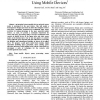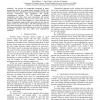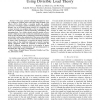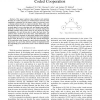ICCCN
2007
IEEE
14 years 5 months ago
2007
IEEE
—an interplay between mobile devices and static sensor nodes is envisioned in the near future. This will enable a heterogeneous design space that can offset the stringent resourc...
ICCCN
2007
IEEE
14 years 5 months ago
2007
IEEE
— Autonomous localization of nodes in wireless sensor networks is essential to minimize the complex self organization task and consequently enhancing the overall network lifetime...
ICC
2007
IEEE
14 years 5 months ago
2007
IEEE
—In wireless sensor networks, sensor nodes are expected to gather specific information about the environment and send it to the user. The data dissemination usually involves many...
ICC
2007
IEEE
14 years 5 months ago
2007
IEEE
—The localization of the sensor node is a fundamental problem in sensor networks and can be implemented using powerful and expensive beacons. Beacons, the fewer the better, can a...
ICC
2007
IEEE
14 years 5 months ago
2007
IEEE
— We propose two lightweight techniques to detect masquerade attacks on wireless sensor networks (WSN). Our solutions take into consideration, important WSN properties like cover...
ICC
2007
IEEE
14 years 5 months ago
2007
IEEE
— In this paper, we investigate the problem of grouping the sensor nodes into clusters to enhance the overall scalability of the network. A selected set of nodes, known as gatewa...
GLOBECOM
2007
IEEE
14 years 5 months ago
2007
IEEE
Abstract— This paper presents scheduling strategies for sensing workload in wireless sensor networks using Divisible Load Theory (DLT), which offers a tractable model and realist...
GLOBECOM
2007
IEEE
14 years 5 months ago
2007
IEEE
— This paper explores relay selection and selection diversity for coded cooperation in wireless sensor networks, with complexity constraints for the sensor nodes. In previous wor...
DSN
2007
IEEE
14 years 5 months ago
2007
IEEE
The success of sensor-driven applications is reliant on whether a steady stream of data can be provided by the underlying system. This need, however, poses great challenges to sen...
COMSWARE
2007
IEEE
14 years 5 months ago
2007
IEEE
We present a novel distributed range-free technique called ExPLoIT for estimating geographical location of sensor nodes in mobile sensor networks. ExPLoIT is the rst positioning...




